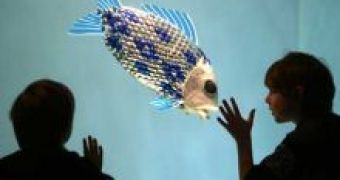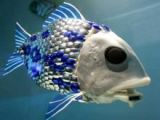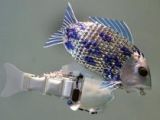London's Aquarium offers to all those who enter one of the most bizarre kinds of fish. Its colors, the ones of any other exotic fish, vary from silver to blue, and it can also swim as well as any other fish. In fact, it is not a "natural fish", but an electronic one, a little robot that fools all adults and fascinates children.
The robot-fish, the first one of its kind, is named - "encoded" really - G9.3 (Generation 9), and, as weird as it might seem, can be your child's favorite toy, if you can afford to pay a few hundred thousand euros.
The blue-cobalt color is, in fact, generated on a computer as a unique color, and the silvery scales are little plastic pieces. The eyes, which seem black, are infrared sensors covered with smoky glass, the same that is used for sunglasses. This is reality, and I know it's hard to believe that G9.3 has no eyes, no scales and it's not alive.
George Simas, 28, Master in Computer Science and member of the Chinese professor's Huosheng Hu team, was asked many times about the reaction people have when they see the robot-fish made and supervised by this team. Most of the times he talks about a certain woman that, even knowing some facts about the fish, couldn't believe the "story" once in front of the aquarium: "Oh, but it's stupid simple! This is an image taken form the ocean and displayed on a screen!" Well, it's redundant to say about the way she reacted when she was told that the fish was in fact real, electronic really, with complete autonomy of movement.
The woman asked a question, the same that many of us would have asked: "How difficult was it for you to create this fascinating robot-fish?". "A robot with flippers isn't hard to create. With movements coordinated by a computer? Also easy. But a robot-fish with absolute autonomy and "real movements" is very hard to manufacture, almost impossible", answered professor Hu.
Every single day, the robot-fish learns how to diminish the quantum of energy needed in order to move using a kind of pump which coordinates its movements in the water. Also, it has four infrared sensors that help avoid "serious injuries" caused by accidents such as colliding into the glass surface of the aquarium.
A trip to SF Universe costs up to 220.000 euro
How many of you were not fascinated by the story of the damned planet Dune or by the tragic game played by one of the most famous SF characters, Ender?
But these are only books, best-sellers as a matter of fact, which show an apocalyptic human world. However, reality, as professor Hu says, guarantees "the sunrise" of new worlds, the ones you were able to see only in your dreams.
"The Age of Robots is as mind-boggling as the one of computers was fifty years ago. Soon, people will have robots as their friends, knowing how to build and increase the performances.", says Hu.
For now, the robot-fish can be bought at a price of around 220.000 euro, from the ones who made it - Shirayama Corporation - the place where you can see other replicas of the already famous G9.3, the little robot with a weight of only three kg.
The chain production of such robots has already started. However, researchers from Shirayama have initiated another project - Paris Aquarium - that will have only robots on display instead of fish, as beautiful and fascinating as the real ones.
Photo Credits - SpiegelOnline

 14 DAY TRIAL //
14 DAY TRIAL // 

